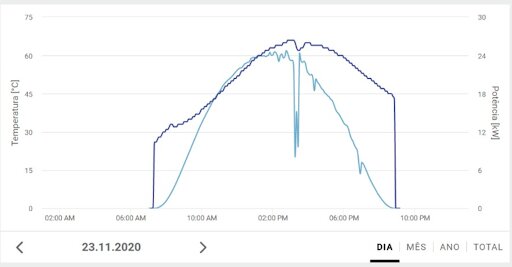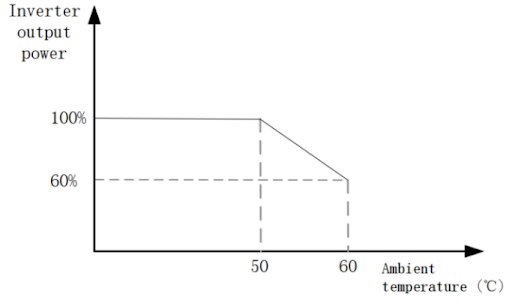Always thinking about the best generation performance, the Tauro inverters They can be quickly adapted according to the different needs of each photovoltaic installation, and can therefore be applied in different situations and topologies.
All machines, whether central or string inverters, always work at maximum power and with a limit temperature determined by the manufacturer.
Above a certain temperature, these devices can be temporarily turned off or operate at reduced power to avoid possible damage to the most sensitive electronic components, avoiding reducing their useful life.
The problem may be linked to a number of factors, such as the temperature derating, or derating due to inverter temperature.
What is temperature derating?
Temperature derating can be described as a limitation of the inverter's output power, with the aim of protecting it if there is excessive temperature in the location where it was installed. It is common to come across the following graph in a photovoltaic inverters datasheet.
Possible causes
Overheating and temperature derating occur for several reasons, including:
- Installation Location: In relation to the location where the inverter is installed, extra care must be taken, as the temperature plays a very important role in the operation of the equipment. Isolated locations, confinement, direct sunlight or even the accumulation of inverters in the same location can cause them to overheat;
- Oversizing: with the overloading of the DC side of the inverter, resulting from the use of a greater number of modules, oversizing guarantees greater energy generation throughout the day, but requires more robustness from the inverter;
- Passive ventilation: If the inverter does not have a cooling system, it may heat up beyond the recommended level, causing a reduction in its output power, especially during peak generation times of the day.
An on-site inspection may be necessary to determine whether the reduction function activates occasionally or due to a problem. That's why we first need to understand how the declassification process works to make a proper diagnosis.
The figure below shows an example of a power reduction curve for a central inverter. In order to prevent overheating of its components, the inverter controls the output power according to the operating temperature.
In addition to reducing power to reduce the internal temperature of components, thermal management can also run fans, if present. These are called forced cooling or active ventilation inverters.
When inverters do not have such technology, they are called inverters with natural convection cooling.
Active ventilation solution for Tauro inverters
Regarding active ventilation, this is treated as a maintenance-free refrigeration system, that is, in which there is no mandatory need for periodic maintenance. In addition to active cooling, the Fronius Tauro features double-wall insulation.
This combination allows the internal temperature and the temperature of sensitive electronic components to be maintained at much lower levels, even under extreme heat.
Due to this innovative cooling system, the Fronius Tauro can offer maximum performance at an ambient temperature of up to 50°C. This in turn has a positive effect on the overall performance of the PV system as well as the service life of the electronics. power.
This active cooling system offers a particular advantage regarding OPEX costs because, unlike some other cooling systems, there are no prescribed maintenance intervals that require the attention of specific experts. All the advantages of active ventilation were also covered in the following article: Active ventilation of photovoltaic inverters.
What are the advantages of active ventilation?
We can therefore conclude that the main advantages of an active ventilation system are:
- Longer service life
- Higher yield
- Flexibility in system design
- Simple and flexible installation
- Low maintenance cost
Double Wall System Solution
At Fronius, we call this two-layer insulation system the Double Wall System, which is an innovative double-wall insulation system on the front of the device. Combined with active cooling technology, the Fronius Taurus can deliver maximum power up to 50°C, even in direct sunlight.
The cooling system therefore not only guarantees a longer component and device life, but also works in conjunction with the double-wall system to provide maximum system performance even at very high temperatures.




















One Response
That's why I set up my active system on two Growatts. When the inverter temperature reaches 50 degrees, the fans turn on, always keeping them below that. I have never had a temperature shutdown again.